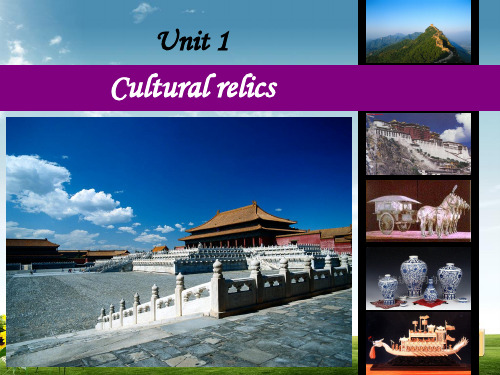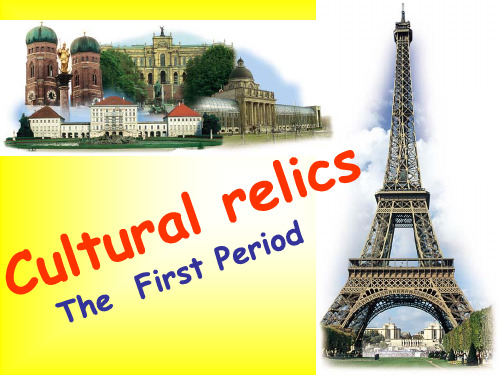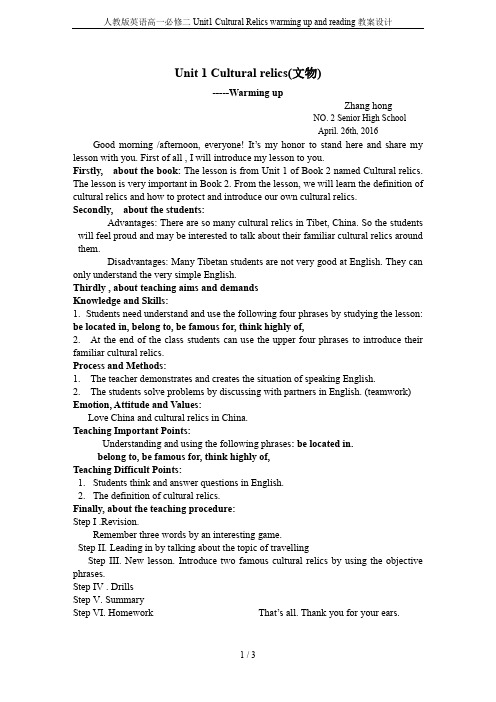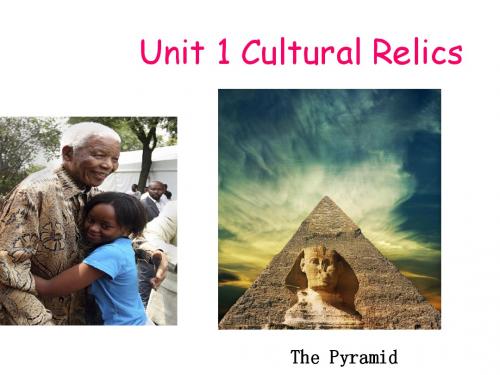人教版英语高一必修二Unit1 Cultural Relics warming up and reading课件(共22张PPT)
- 格式:ppt
- 大小:3.73 MB
- 文档页数:22





Unit 1 Cultural relics(文物)-----Warming upZhang hongNO. 2 Senior High SchoolApril. 26th, 2016 Good morning /afternoon, everyone! It’s my honor to stand here and share my lesson with you. First of all , I will introduce my lesson to you.Firstly, about the book: The lesson is from Unit 1 of Book 2 named Cultural relics. The lesson is very important in Book 2. From the lesson, we will learn the definition of cultural relics and how to protect and introduce our own cultural relics.Secondly, about the students:Advantages: There are so many cultural relics in Tibet, China. So the students will feel proud and may be interested to talk about their familiar cultural relics around them.Disadvantages: Many Tibetan students are not very good at English. They can only understand the very simple English.Thirdly , about teaching aims and demandsKnowledge and Skills:1.Students need understand and use the following four phrases by studying the lesson: be located in, belong to, be famous for, think highly of,2.At the end of the class students can use the upper four phrases to introduce their familiar cultural relics.Process and Methods:1.The teacher demonstrates and creates the situation of speaking English.2. The students solve problems by discussing with partners in English. (teamwork) Emotion, Attitude and Values:Love China and cultural relics in China.Teaching Important Points:Understanding and using the following phrases: be located in.belong to, be famous for, think highly of,Teaching Difficult Points:1.Students think and answer questions in English.2.The definition of cultural relics.Finally, about the teaching procedure:Step I .Revision.Remember three words by an interesting game.Step II. Leading in by talking about the topic of travellingStep III. New lesson. Introduce two famous cultural relics by using the objective phrases.Step IV . DrillsStep V. SummaryStep VI. Homework That’s all. Thank you for your ears.Learning guide (导学案)Step I. RevisionRemember three words by a physical game.Step II. Leading in & New LessonsLead in by talking about the topic of travelling.A: use simple sentences structure to talk about travelling.I want to visit…(India, Canada, USA)I am going to see… ( the Potala Palace, the Great Wall, the Big Ben)I plan to have a look at… (Huang Guoshu Waterfall, Mount Qomolangma)B: Lets students understand the meanings of the following phrases by looking at two pictures: be located in, belong to, be famous for, think highly of.1.A: What’s this?B: It’s the Big BenA: Where is it?B: The Big Ben is located in UK.A: That means it is in UK.B: You are right. It belongs to UK.2.A: Look, the Great Wall.B: It’s really wonderful.A: I also want to visit it.B: Me too. You know that China is famous for the Great Wall.A: Sure, All people think highly of it.B: We Chinese are proud of it.Step III. DrillsA: Read after me and then read by yourselves.B: Use the upper four phrases to introduce the cultural relics around them.] C: Fill in the blanks. (be located in , belong to , be famous for , think highly of.)1. Tibet ------ --- --- ------- the Potala Palace.2. Tibet ------ ------ ------- the west of China.3. Tibet ------ ------- China.4. The teacher ------ ------ ------ Zhaxi.StepIV. SmmaryStepV. Homework1. Use the phrases you learned in class to introduce the cultural relics in your hometown to your classmates.2. Write a short composition to introduce the cultural relics around you.StepVI.Blackboard DesigningUnit 1 Cultural relicsWarming upI.RevisiongreetingII.New lessons:I want to visit…I am going to see…I plan to have a look at…Be located inBelong toBe famous forThink highly of。

Unit 1 Cultural relicsPeriod 2 Warming up and pre-reading教学设计I. Teaching contents:Warming up and pre-readingII. Teaching aims:1). To learn the knowledge of the cultural relics.2). Discuss how to protect our cultural relics.3cultural relics, rare, valuable, survive, vase, rare, DynastyKey pointsTo understand cultural relics.DifficultiesTalk about cultural relics at home and abroad in English freely.IV. Teaching procedure:.Step I : GreetingsThe teacher greet the whole class.Step II: Words Preview: (PPT 3)Review some words of this period:cultural; relic; rare; valuable; dynasty; ivory; amberStep III: Lead-in & Warming up (PPT 4—6)1). Guessing:Teacher present some pictures and statements ,let the students guess whtat or where it is.The Great Wall; The Pyramid ; Taj Mahal2)Teacher show some pictures. They are all very famous places in China or in the world. Ask the students to think these over:A. Can you name them out?B.Who have the right to own and confirm them?(The shown pictures: Group 1;①Yuanmingyuan; ②Forbidden CityGroup 2: ③Ming Dynasty vase ;④Taj Mahal; ⑤ivory dragon boatand Mogao Caves)Let the students name out the famous places in the pictures, and tell them they are cultural relic s. And explain what cultural relics are.A. a cultural relic is sth. that survive d for a long timeB. a cultural relic may be a part of old thing has remain ed when the rest of it had been destroyedC.or a cultural relic is something rather rare(while showing these photos, teach the new words in red: cultural relics, survive, remain, rare)3) Let the students make some more examples of cultural relics, including the ones inside our country or in other countries, especially the ones in our location.4)Let the students try to use some adjectives to describle the cultural relic(ppt21)Step IV:Discussing 1As we all know that cultural relics are rather valuable, rare, and sometimes, it is in very high price.1. Then can you tell the value of the cultural relic? (Have the students discussed for some time inteams, then get their answers by expressing in class.)(There will be a lot of possible answers. Eg: From the cultural relics we can know what people did in the past, and we can know the cultures at that time, and maybe we can know the technology of making them…)2. How to protect the cultural relics? (The same as Question 1)(There will be a lot of possible answers. Eg: Having the idea of protecting our cultural relics; d on’t damage them; use them in a right way…..)StepV: Discussing 21. If you find a cultural relic, what will you do with it?2. Do you think to whom the cultural relics belong?(All cultural relics belong to all people and whole society.)Have the students to discuss the first question for about two or three minutes, then show the answer for their team. Then the same way for Question 2.(While discussing, teach the new phrase in red)Step VI: Pre-reading1).Ok, you have know something about cultural relics, have you ever seen a piece of amber?And what do you know about it?Show some pictures of amber. Let students know what the amber is and its value.color yellow- brownfeel like feel as hard as stoneAmber is the fossil(化石) form of resin(树脂) from trees.It takes millions of years to form.2). Can you imagine a house made of ambe r?Please preview “In search of theamber room.”Step VI: Homework1. Read the new words and try to memorize bold words in this unit.2. Finish exercise 2on page 42.3. Preview “In search of the amber room” and find out all the years appeard in the text.V. Blackboard DesignUnit 1 Cultural relicsWarming up & pre-readingWhat is cultural relic s?A.a cultural relic is sth. that survive d for a long timeB.a cultural relic may be a part of old thing has remain ed when the rest of it had been destroyedC. a cultural relic is something rather rare。